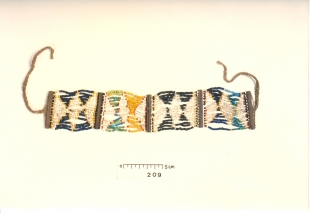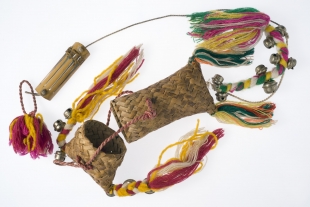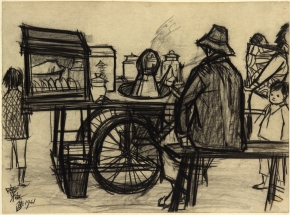TELDAP Collections
| Collections of the Shung Ye Museum of Formosan |
|
Aborigines The Shung Ye Museum of Formosan Aborigines was established in 1994 as a specialist museum founded on the collection and display of artifacts of Taiwan’s indigenous peoples. It is dedicated to promoting mutual understanding between different ethnic groups, through careful research, preservation and explanation of the essence of Aboriginal cultures. Achievement of these aims of mutual respect and appreciation will help to create a harmonious and gentle society. The museum was originally based on the donation by its founder and chairman Safe C.F. Lin of his personal collection of Taiwanese Aboriginal artifacts acquired over many years in keeping with his desire to put something back into the community. By sharing his treasures with the whole of society he hoped to contribute to the ideal, “In loving our native place we must cherish each other’s cultures.” Shung Ye Museum’s main displays introduce the natural environment of Taiwan’s indigenous peoples, their daily utensils, clothing and personal decoration, ritual objects and religious life. Films shown in the auditorium provide an understanding of the present conditions of Aboriginal life. The museum also has a special exhibition room where related exhibitions are held at regular intervals to broaden visitor’s field of concern, and to present the many faces of humankind’s culture. Ethnology Collections of Shung Ye Museum of Formosan Aborigines are either purchased, donated, collected or loaned. There are a total of 1866 artifacts which include 1673 artifacts from different tribes and a donation of 193 photographic plates taken by Torri Ryuzo. Artifacts of Museum's collection can be categorized according to ethnic groups, including Atayal (150), Saisiyat (28), Amis (207), Bunun (36), Tsou (47), Rukai (120), Paiwan (453), Puyuma (52), Yami/Tao (105), Sakizaya (11), Kavalan (10), the Pinpu (11), Pazih (10), Soloman Islands (2), Nepal (1) Africa (2), Photographs (359) and items with unclear origins (269). The categories of artifacts are mostly costume and ornaments, followed by ceremonial instruments and handicrafts. Details of ethnology collections in the museum are classified into the following categories: Costume and Clothes, Textile and Ornaments, Livelihood tools, Ceremonial instruments and Handicrafts.
Words from Chairman C.F. Lin, the N.W. Lin Foundation for Culture and Education: Shung Ye Museum of Formosan Aborigines established under the spirit of "Love our land; love each other's culture." After a decade of preparation, now that the museum has opened for fifteen years. The establishment of this museum is a payback to the Taiwan society from the Shung Ye Co., and is represents the entrepreneur's expectation and giving on inheriting the local culture. Such an ideal is also the initial thought on my own collection of Taiwan's art work. Based on the ideal of "Giving something back to the community," I have donated my personal art collections to Shung Ye Museum of Formosan Aborigines, hoping to share with more people on such cultural treasures of Taiwan. There was no market of art in Taiwan at the time I began collecting art work of local artists. That was an innocent era for the painting industry, and also the era when campaign of local culture were ready to take-off. For reasons, I was honored to have the chance of meeting with many leading persons and elite artists on campaigns for Taiwan Art, whom I can learn from and have maintained friendship for decades. There are certain relationship between economic development and artistic activities, but personally owning an exquisite art piece does not prove one's taste is even better than the others. The reason I 'm deeply attracted to the local art in Taiwan is by the human touch of sentiment, emotion and feelings that reflect the beauty of everyday's life of ordinary people. This is also my prior principle when it comes to collecting art work. Even after the economy in Taiwan soared, the market value of art work was is none of my concern, nor had I worried about the problem of the added-value on individual art work. Therefore, I will not see myself as a collector, but instead, enjoy being an art lover among the others. Apart from having more chances to appreciate art works, the happiest thing for an experienced art lover, is to meet face-to-face and communicating with their admired artist who represents the source of inspiration. I have begun collecting art in the much early stage; therefore, I was fortunate to have the chances of meeting the artists and to witness the legend of Taiwan Art Industry. For example, I was greatly encouraged of able to acquire the symbolic masterpieces such as, "Bridal Chamber", "Chiaotien Temple at Pekang" by Artist Chin Chen who is renowned as "the First lady painter." Chen was already famously known for her art work, and such significant collecting experience was like a ceremony specially, at the period when art industry was not commercially contaminated. However, years after I remain firmly on my collecting principle of no investment concerns as these art works have become very collectable. There are works of painters, youth painters along with collections from the pioneer painters and their fellow artists, are now collected by the Museum. The eras across decades, covering a variety of unique features and not one particular style is revered over others. Through all kinds of skills to represent the beauty, abundant and familiar sketch of Taiwan, we can gaze at the natural, innocent and adorable expression of this land with affection, which I am hoping to inspire resonance.
|
























